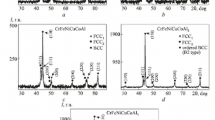A six-component system of CoNiCuCrx high-entropy alloys with different contents of chromium (where x = 0, 0.5, 1.0, 2.0, and 3.0 mole) is obtained by the method of argon-arc melting in a МІFІ-9 study. By the methods of X-ray diffraction analysis, scanning-electron microscopy, and indentation, we investigate the influence of chromium on the crystalline structure, microstructure, and hardness of these alloys in the as-cast state. In their structure, depending on the chromium content, we detect a mixture of the following phase components: two face-centered cubes + a body-centered cube + an intermetallic σ-phase (FCC1 + FCC2 + BCC + σ). It is also established that, as the chromium content increases, we observe the formation of the bcc structure and the σ-phase, which is the predominant factor of hardening of the alloy.



Similar content being viewed by others
References
J. W. Yeh, S.-K. Chen, S.-J. Lin, J.-Y. Gan, T.-S. Chin, T.-T. Shun, C.-H. Tsau, and S.-Y. Chang, “Nanostructured high-entropy alloys with multiple principal elements: novel alloy design concepts and outcomes,” Adv. Eng. Mater., 6, No. 5, 299–303 (2004).
M. V. Demchenko, O. P. Gaponova, O. M. Myslyvchenko, B. Antoszewski, and M. M. Bychenko, “Microstructure and properties of AlCrFeCoNiCux high-entropy alloys,” J. Eng. Sci., 5, No. 1, 11–16 (2018).
O. N. Senkov, G. B. Wilks, D. B. Miracle, C. P. Chuang, and P.K. Liawd, “Refractory high-entropy alloys,” Intermetallics, 18, No. 9, 1758–1765 (2010).
T. K. Biswas and N.P. Gurao, “Deciphering micromechanisms of plastic deformation in a novel single phase FCC based MnFeCo-NiCu high entropy alloy using crystallographic texture,” Mater. Sci. Eng.: A, 657, 224–233 (2016).
S. Huang, A. Vida, A. Heczel, and E. Holmström, “Thermal expansion, elastic and magnetic properties of FeCoNiCu-based highentropy alloys using first-principle theory,” J. Miner. Met. Mater. Soc., 69, No. 11, 2107–2112 (2017).
V. F. Gorban', N. A. Krapivka, and S. A. Firstov, “High-entropy alloys: interrelations between electron concentration, phase composition, lattice constant, and properties,” Fiz. Met. Metalloved., 118, No. 10, 1017–1029 (2017); English translation: Phys. Met. Metallogr., 118, 970–981(2017).
M. Ren, B. Li, and H. Fu, “Formation condition of solid solution type high-entropy alloy,” Trans. Nonferr. Met. Soc. China, 23, No. 4, 991–995 (2013).
A. Takeuchi and A. Inoue, “Classification of bulk metallic glasses by atomic size difference, heat of mixing and period of constituent elements and its application to characterization of the main alloying element,” Mater. Trans., No. 12, 2817–2829 (2005).
Author information
Authors and Affiliations
Corresponding author
Additional information
Translated from Fizyko-Khimichna Mekhanika Materialiv, Vol. 56, No. 3, pp. 81–85, May–June, 2020.
Rights and permissions
About this article
Cite this article
Myslyvchenko, О.M., Krapivka, М.О., Tereshchenko, О.S. et al. Influence of Chromium on the Phase Composition and Specific Features of Hardening of the MnFeCoNiCu High-Entropy Alloy. Mater Sci 56, 375–380 (2020). https://doi.org/10.1007/s11003-020-00440-y
Received:
Published:
Issue Date:
DOI: https://doi.org/10.1007/s11003-020-00440-y




